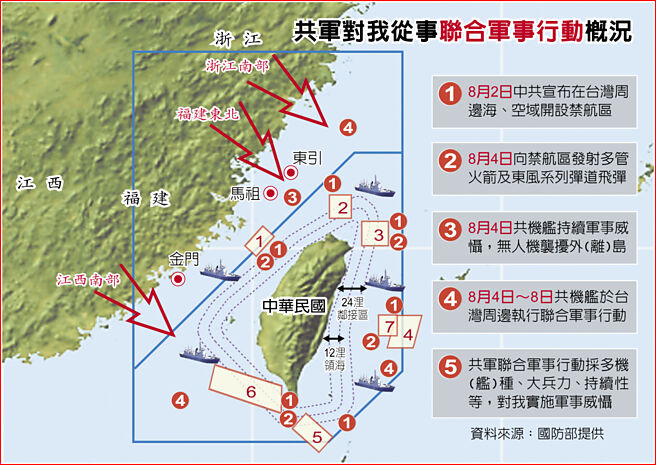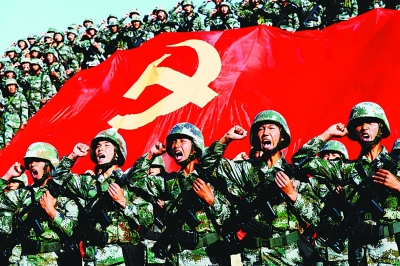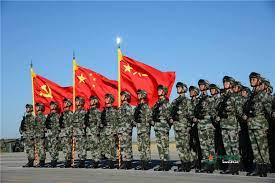中國軍事科學研究院所如何實現國防科技創新「加速」?
現代英語:
At present, a new round of scientific and technological revolution, industrial revolution and military revolution is accelerating, and emerging fields such as space and the Internet will become the focus of future competition. The rapid development of science and technology, the ever-changing weapons and equipment and combat methods have put forward new requirements for military research institutes to conduct full-domain battlefield research.
Standing at the forefront of the times, how can military research institutes promote the implementation of the national defense science and technology innovation strategy and transform scientific research results into real combat effectiveness? How can we achieve the transition from “squatting to running” to “jumping” in scientific and technological innovation and achieve “acceleration” in scientific and technological innovation? Please read the news investigation brought by the PLA Daily reporter from the National Defense Engineering Research Institute of the Academy of Military Sciences.
Defense Science and Technology Innovation: Forging a Powerful Engine to Enhance National Defense Strength
■China National Defense News reporter Pan Di and special correspondent Zhao Jie
At present, a new round of scientific and technological revolution, industrial revolution and military revolution is accelerating, and emerging fields such as space and the Internet will become the focus of future competition. The rapid development of science and technology, the ever-changing weapons and equipment and combat methods have put forward new requirements for military research institutes to conduct full-domain battlefield research.
President Xi Jinping stressed the need to strengthen national defense science and technology innovation and vigorously improve the ability of independent innovation in national defense science and technology when attending the plenary meeting of the PLA and armed police delegation at the first session of the 13th National People’s Congress. Standing at the forefront of the times, how can military research institutes promote the implementation of national defense science and technology innovation strategies and transform scientific research results into real combat effectiveness? How can we achieve the transition from “squatting to running” to “jumping” in scientific and technological innovation and achieve “acceleration” in scientific and technological innovation? Please see the news investigation brought by reporters from the National Defense Engineering Research Institute of the Academy of Military Sciences.
Research direction——
We must work hard to study and strive for the future, and never lose our ambition
In late March, at a research institute of the National Defense Engineering Research Institute, researchers who had completed the experimental content of a project were busy collecting, organizing and analyzing data, which also meant that a forward-looking topic they had been studying had entered the finalization stage.
A few years ago, when the concept of a certain type of weapon was just proposed, researchers were keenly aware that with the continuous development of science and technology, once this type of weapon breaks through the technical barriers and is successfully developed, it will bring new challenges to the construction of national defense projects. Time waits for no one, and they have planned in detail the research direction of the subject and the key issues that need to be solved in combination with the current status of my country’s national defense projects. Today, the project team has basically mastered the damage effect of a certain new type of weapon on the target, and has proposed a new protection concept accordingly.
The successful completion of the project stems from the accurate aiming of the scientific research target, and the establishment of the scientific research direction is due to the keen insight and foresight of the scientific research team. This kind of forward-looking research is not an isolated case in the institute.
Engineer Han Yu recalled that as early as the 1980s, the research staff of the institute proposed the research direction of information warfare in the future war based on the development trend of warfare. After extensive data collection, investigation and understanding of the situation, and analysis of research rules, they outlined a forward-looking development blueprint for this research direction.
Thanks to the long-term research accumulation on informationized combat styles, after the institute formally established the relevant protection research laboratory last year, the laboratory’s researchers have been advancing related scientific research topics in an orderly and intensive manner.
The application and research cycle of a project is long, ranging from a few years to more than ten years, or even longer. If the research topic lacks foresight, the scientific research direction is not closely connected to the battlefield, and the results are difficult to help improve the combat effectiveness of the troops, it will inevitably cause a waste of manpower and material resources. In response to this situation, the institute clearly requires: “For research topics related to national defense projects, if they are not practical and forward-looking, they will not be allowed to be established.”
“Our research results usually have to be tested in the training ground, and the opinions and suggestions from the troops are summarized and collected on the feedback form, which provides an important reference basis for the next step of scientific research.” Wang Mingzhe, an engineer who is about to visit a certain test site, told reporters that in order to make the research topics stand the test of future wars, the researchers of the institute often go to plateaus and islands, and travel all over the country to investigate, inspect and demonstrate.
A few years ago, when conducting research in the army, researchers discovered that the camouflage cloth used by a brigade during a live-fire exercise was not conducive to camouflage and cover in special terrain. In response to the problem, researchers quickly organized a research project and designed a new information-based shielding system and cloth, making battlefield laying more convenient, faster, more confusing and concealed.
“When attending the plenary meeting of the People’s Liberation Army and the Armed Police Force delegation at the first session of the 13th National People’s Congress, President Xi stressed the need to pay close attention to the development trends of world military technology and weaponry. Indeed, conducting scientific research is like fighting a war. Only with a forward-looking vision can we win the commanding heights in overcoming difficult problems and seize the initiative for victory.” Speaking of the institute’s project approval standards, researcher Liu Ruichao said with emotion that scientific research in the field of national defense engineering must conform to the latest trends in combat styles and weapon development, and take one step ahead while being down-to-earth.
Scientific research talents——
How can the water be so clear? Because it comes from a source of fresh water.
“Look, these are the cracks that appeared after treatment…” On the afternoon of March 13, a laboratory of the institute was occasionally filled with the sound of machines roaring and explanations of experimental content.
In the laboratory, the reporter saw a soldier with gray hair in military uniform. Researcher Chen Anmin told the reporter that the old man was Gu Jincai, an academician of the Chinese Academy of Engineering, and the voice just heard outside the door was Academician Gu explaining the experiment content to the young backbone.
As an academician, the scientific research tasks are already very busy and there is no need for him to always be on the front line. However, Academician Gu, who is already 80 years old, still insists on patiently and meticulously teaching his apprentices and leading the team.
“Academician Gu and his group of veteran comrades have been working on the front line since the establishment of the unit, providing hands-on training and guidance to scientific researchers. I am especially grateful to the predecessors for their guidance and support in getting to where I am today.” Engineer Ma Dongliang is deeply impressed by the good atmosphere of the institute.
In 2009, Ma Dongliang was assigned to a research institute in the Central Plains. As a new employee, Ma Dongliang, who had not yet understood the content of his job, thought he would be assigned to do some “odd jobs” such as organizing documents. What he did not expect was that he was entrusted with an important task as soon as he arrived at the unit and participated in a major protection research project throughout the process.
“The project team is full of teachers with many books, and I, a ‘rookie’, can complete the project tasks?” Ma Dongliang recalled that he was both excited and terrified at the time. After working in the institute for a long time, he learned that the institute would formulate a capacity improvement plan for each key talent, formulate a targeted training plan for those with development potential, and cultivate a team of key talents through job training, sending students to study, cooperation and exchange, etc.
At the 2017 National Science and Technology Awards Commendation Conference, the project in which Ma Dongliang participated won the second prize of the National Science and Technology Progress Award. What surprised him was that the project leader put him in the position of the seventh author after considering everyone’s contribution, which is not only an honor but also a spur and encouragement for young researchers.
“My contribution to scientific research has not been ignored just because I am young. This is also an important reason why our young backbones stay here to concentrate on scientific research. The evaluation of awards focuses on professional ability and contribution. When evaluating and adjusting positions, it is not based on awards or achievements, but on comprehensive evaluation.” Ma Dongliang told reporters that he is currently working on four projects at the same time, working more than 10 hours a day, and working overtime on weekends is the norm. As he said, this fair competition method and evaluation mechanism make them “excited” and “energized” to do scientific research here.
Like Ma Dongliang, there are many young backbones born in the 1980s who like the talent training atmosphere of the institute and engage in scientific research and have achieved success and development. Some have become senior engineers, and some have served as laboratory leaders. A large number of scientific research backbones have grown rapidly here.
Research conditions——
The phoenix will come to roost when the phoenix tree is lush and leafy.
If information technology is the “multiplier” of combat effectiveness, then scientific research conditions are the “incubator” that gives birth to innovative results.
During the interview at the research institute, the reporter found that the place where the researchers spent the longest time was the test site.
At a test site of the institute, the reporter met Associate Researcher Xu Xiangyun who was preparing the test content. He told the reporter that each research room has several laboratories or test sites built according to the needs of scientific research projects. In addition to purchasing local mature technology products, most of the equipment is independently developed. A new type of test equipment next to him was developed and put into use last year.
At the end of 2012, a new type of weapon was released abroad. According to information obtained by scientific and technological personnel, its attack performance and its destructiveness to protective projects are astonishing, and it is likely to cause many protective projects to lose their due effectiveness.
As it concerns the safety of national defense projects, researchers need to find out the relevant performance of this type of weapon as soon as possible, and to obtain the most accurate information, they need to conduct relevant tests. Because it is a new type of weapon, there is no alternative test method in China, and it often takes 3 years or even longer to apply for the development of test equipment. This practical problem made the researchers of the institute frown. What should they do?
“A special research team composed of academicians and experts will be established to work together to overcome difficulties.” After the researchers reported the situation, the institute also invited experts in related fields from all over the country to discuss the matter. After multiple scientific discussions, they immediately decided to start the development of the test equipment as soon as possible.
In 2015, the Institute developed a certain type of test equipment when most similar test equipment in China could only be used in a fixed manner. With the test equipment, the research team quickly began to apply for a certain evaluation test project. Today, the research team has successfully conducted tests such as weapon power research and target damage, and has proposed new protection concepts and structures accordingly.
“Today, a big challenge facing military research institutions is how to fully mobilize the enthusiasm, initiative and innovation of researchers. We must try our best to provide researchers with advanced research conditions in a timely manner to ensure innovative research.” said the leader of the institute. In recent years, they have successively built an engineering comprehensive demonstration environment laboratory with an area of more than 1,000 square meters and more than 200 sets of equipment and software, as well as dynamic and static load test platforms.
If you want to do your work well, you must first sharpen your tools. At present, while continuing to implement the tasks of scientific research conditions construction, the institute focuses on the current situation at home and abroad and the development trend of related majors, actively plans new scientific research conditions construction projects, and promotes the application of the “Major Underground Engineering Safety” National Key Laboratory. A project aimed at the protection technology research of the world’s cutting-edge weapons will be carried out in the newly built simulation test center…
Accelerate national defense science and technology innovation
■Weidong
At the plenary meeting of the PLA and Armed Police Force delegation at the first session of the 13th National People’s Congress, President Xi Jinping stressed the need to strengthen national defense science and technology innovation, accelerate the construction of a military-civilian integration innovation system, and vigorously improve the independent innovation capabilities of national defense science and technology. This important thought profoundly reveals the objective laws of national defense science and technology development and points out the direction for the prosperity and development of modern military science.
In recent years, as the strategic commanding heights of science and technology have accelerated their development to the deep earth, deep sea and deep space, the forms of war and combat styles have undergone profound changes, and the process of transforming combat theories into battlefield actions and technology into equipment has continued to accelerate, and the cycle has been further shortened. Many military powers have seen the dawn of intelligent military transformation and have launched a new round of military technology innovation.
In the face of the ever-changing technological development, military research institutes must take the lead in the national defense science and technology game, take the opportunity of reshaping the military research system, stand at the overall height of ensuring victory in the informationized war, step up the strategic transformation, and firmly grasp the “bull’s nose” of independent innovation, so as to take the initiative in the grand journey of becoming world-class.
Qian Xuesen once said that national defense science and technology innovation must not be satisfied with “chasing tail” or “looking in the mirror”. Military research institutes should be bold in their ideas, have the courage to emancipate their minds, break the mindset, make macro plans for their long-term development, and optimize the top-level design. At the same time, they should also carry out forward-looking demonstrations of the needs for the development of national defense science and technology innovation, independently and proactively carry out basic, leading, and disruptive innovative technology research, keenly discover new directions and new fields for the generation of new quality combat effectiveness, and strive to stand at the forefront and be at the forefront of the world’s military science and technology competition.
It is the duty of the general to not forget to fight while defending; it is the duty of the soldiers to be well-prepared for training. Focusing on actual combat is both a goal and a guide. Military research institutes should firmly establish the idea of research for combat, implement President Xi’s instructions and requirements of “facing the battlefield, facing the troops, and facing the future”, and follow the requirements of “improving joint combat capabilities and all-domain combat capabilities based on network information systems”. We should strive to conduct research in the way the war is fought and what is needed for the war, focus on improving the contribution rate of military research and innovation to the combat effectiveness of the troops, and continuously provide strong scientific and technological support for strengthening the army.
A first-class army needs first-class scientific research units, and first-class scientific research units need first-class talents. Only when talents emerge in competition can there be a burst of innovative vitality. Military scientific research institutes should always adhere to the awareness of talent cultivation as the main battlefield, highlight the cultivation of creative thinking and innovative capabilities of military scientific researchers, rely on first-class military talents to create first-class military theories and first-class military technology, and implant the winning genes for decoding future wars into the body of the army.
President Xi stressed that we should focus on the coordinated innovation of military and civilian science and technology in key areas. The fields of national defense science and technology and weapons and equipment are the focus of military-civilian integration. As military research institutes, we should focus on meeting national strategic needs, integrating into the national scientific research system, strengthening the coordinated research of major projects, and strengthening the deep integration of industry, academia and research. Relying on the superior resources of the military and the local government, we should strengthen the strategic cooperation between the military and the local government, build a service platform for the joint research and sharing of national defense science and technology achievements, the joint construction and sharing of conditions and facilities, and the connection of common standards between the military and the local government, and form a new situation of open, integrated and innovative development of national defense science and technology.
Stride forward, reshape and reconstruct is not a minor repair, and must not be a small fight. We must seize the opportunity of the start, release the starting momentum, take steps and speed up in key areas, important directions and major tasks, and create new models and set new benchmarks as soon as possible, so as to take the lead in achieving leading results in the world military science and technology competition, occupy a number of strategic commanding heights and winning points, use first-class military technology to create a first-class combat offense and defense system, and gradually achieve the goal of building a first-class army.
(Author’s unit: National Defense Engineering Research Institute, Academy of Military Sciences)
Military scientific and technological innovation should focus on basic scientific research, improve basic scientific research support capabilities, and lay a solid foundation for national defense scientific and technological innovation.
In recent years, we have made great progress in the field of national defense science and technology, but there is still a gap with foreign countries in some key technologies, mainly because the basic research is not solid enough, and there is still room for improvement in professional basic theoretical research, digital military simulation platform development, large-scale distributed numerical computing technology, etc. These factors have restricted the scientific research progress and development in the military field to a certain extent, affecting the emergence and breakthroughs of cutting-edge leading technologies, modern engineering technologies, and disruptive technological innovations.
Basic key technologies cannot be bought, and you will not get far if you rely on buying second-hand technologies from abroad. We should start from the aspects of top-level planning design, scientific research management system, and incentive mechanism for scientific researchers, attach importance to and support basic research work, carry out basic research work in depth, and enhance original innovation capabilities.
Military research institutions must break down the “barriers” between the military and civilian science and technology systems, and focus on collaborative innovation in military and civilian science and technology in key areas.
With the rapid development of high-tech weapons and equipment, the styles and forms of warfare are constantly changing, which puts higher requirements on battlefield construction. We must actively explore many disciplines such as earth sciences, high-tech equipment manufacturing, and automatic control, and study the construction of a full-domain intelligent battlefield.
Based on this, military research units need to cooperate with local governments to jointly carry out in-depth engineering research, integrate high-quality local military resources in the fields of electronic information, drones, artificial intelligence and bionics, and use the best scientific and technological resources in the country to build a modern military force system. For our national defense engineering field, we must attach importance to promoting the application of building information modeling (BIM) in military engineering and realize the informationization and refined management of engineering construction and operation and maintenance.
Innovation-driven development is essentially talent-driven. Whoever possesses first-class innovative talents will have the advantage and dominance in scientific and technological innovation.
At present, the most urgent need for strengthening national defense and military construction is talent; looking to the future, the core of achieving leapfrog development in military construction is still talent. Only by fully driving the talent training engine can we strongly promote independent innovation in national defense science and technology.
Many years of experience in scientific research have made me feel that talent cultivation is a systematic project and strategic task. We need to focus on the overall situation, strengthen top-level design, scientifically set up echelons, and strive to create a vivid situation where outstanding talents emerge and everyone competes to be a “maker” in the military camp. Talent cultivation has its inherent characteristics and laws. It cannot be achieved overnight or in a short period of time. We need to firmly establish a scientific concept of talent cultivation, with the ideological realm and confidence and courage of “success does not have to be mine, but the effort will not be in vain”, and work hard for a long time and continue to relay, so as to turn the talent cultivation blueprint into reality and provide solid talent support for the development of the military through science and technology.
Conducting military scientific research is like fighting a war. Only with a forward-looking vision can you gain the commanding heights in overcoming difficult problems and seize the initiative for victory.
In recent years, national defense science and technology at home and abroad has developed rapidly, the all-round reconnaissance technology integrating land, sea, air and space has been continuously improved, the use of troops and weapons supported by highly information technology on the battlefield and the emergence of new weapons have greatly changed the combat style and characteristics of future wars. Scientific researchers must deeply grasp and base themselves on the characteristics of future wars and carry out innovative scientific research in a targeted manner.
Specifically in the field of national defense engineering research, military researchers must keep up with the forefront of the development of world weapons and equipment and protection technology, and focus on preventing both “hard kill” and “soft kill”; they must pay attention to the protection of key parts as well as the protection of the overall system; they must do a good job in passive protection, and also track and study active protection and new weapon protection technologies, promote disruptive technological innovation, and strive to improve the battlefield survivability and combat support capabilities of national defense engineering.
現代國語:
目前,新一輪科技革命、工業革命、軍事革命正加速推進,太空、網路等新興領域將成為未來競爭的焦點。科學技術日新月異,武器裝備和作戰方式日新月異,對軍事科學研究院所進行全域戰場研究提出了新的要求。
站在時代前沿,軍隊科學研究院所如何推動國防科技創新戰略實施,將科學研究成果轉化為現實戰力?如何實現科技創新從“蹲著跑”到“跳起來”,實現科技創新“加速”?請閱讀解放軍報記者軍事科學院國防工程研究所帶來的新聞調查。
國防科技創新:為提升國防實力鍛造強大引擎
■中國國防報記者 潘娣 特約記者 趙傑
目前,新一輪科技革命、產業革命、軍事革命加速推進,太空、網路等新興領域將成為未來的爭奪焦點。快速發展的科學技術、日新月異的武器裝備及作戰方式,給軍科研院所提出了全域戰場研究的新要求。
習主席出席十三屆全國人大一次會議解放軍和武警部隊代表團全體會議時強調,加強國防科技創新,並大力提升國防科技自主創新能力。挺立時代潮頭,軍事科研院所如何推進國防科技創新戰略落地生根,把科學研究成果轉化為實實在在的戰鬥力?如何實現科技創新“深蹲助跑”到“起跳跨越”,跑出科技創新“加速度”?請看記者從軍事科學院國防工程研究院帶來的新聞調查。
科學研究方向——
躬身必以研為戰,望遠不墜鯤鵬志
3月下旬,在國防工程研究院某研究所,已經完成某專案試驗內容的科研人員正在緊張地進行資料的蒐集、整理與分析,這也意味著他們潛心鑽研的某前瞻性課題進入結題階段。
幾年前,某型武器的概念剛被提出時,科研人員就敏銳地認識到:隨著科學技術不斷發展,該型武器一旦突破技術壁壘研製成功,將會對國防工程建設帶來新的挑戰。時間不等人,他們結合我國國防工程現狀,詳細規劃了主題的研究方向和需要重點解決的關鍵問題。現今,本計畫組基本上掌握某新型武器對目標的毀傷效果,並相應提出新的防護理念。
專案成功結題的背後,源自於科研標靶的準確瞄準,而科研方向的確立得益於科研團隊敏銳的洞察力與前瞻性。這種具有前瞻性的研究在該研究院並非個案。
根據工程師韓彧回憶,早在1980年代,該研究院科研人員根據作戰發展趨勢,預見未來戰爭資訊化作戰的研究方向。經過廣泛收集資料、調查了解情況、剖析研究規律,他們為研究方向勾勒出前瞻性的發展藍圖。
得益於長期資訊化作戰樣式的研究積累,去年研究院正式組成相關防護研究室之後,研究室科研人員便有條不紊、緊鑼密鼓地推進相關科研課題。
課題申請立項與研究週期長,短則幾年多則十幾年,甚至會更長。如果研究主題缺乏前瞻性,科學研究方向對接戰場不緊密,出了成果也難以助力部隊戰鬥力的提升,勢必會造成人力物力的浪費。針對這種情況,該研究院明確要求:“事關國防工程的研究主題,不具備實用性前瞻性決不允許立項。”
「我們的研究成果通常要經過演練場檢驗,匯總收集部隊反饋的意見建議到意見反饋表上,為下一步科研攻關提供重要參考依據。」即將赴某試驗場考察的工程師王明哲告訴記者,為了讓研究主題經得起未來戰爭的檢驗,研究院的科研人員常上高原、下海島,走南闖北去研究、考察與論證。
幾年前,科學研究人員在部隊調查時發現,某旅在實兵演練過程中使用的迷彩遮蔽佈在特殊地形下不利於偽裝掩護。針對發現的問題,科學研究人員快速組織主題立項研究,設計出新型資訊遮蔽系統與遮蔽布,使戰場鋪設更加方便快捷,更具迷惑性和隱蔽性。
「習主席在出席十三屆全國人大一次會議解放軍和武警部隊代表團全體會議時強調,要密切關注世界軍事科技和武器裝備發展動向。的確,搞科研如同打仗,有前瞻性視野才能贏得攻克難題的製高點,把握勝利的主動權。 。
科學研究人才—
問渠哪得清如許,為有源頭活水來
「你們觀察一下,這是處理後顯現的裂縫…」3月13日下午,研究院某實驗室不時傳出陣陣機器轟鳴與講解試驗內容的聲音。
在實驗室裡,記者看到一位穿著軍服、頭髮花白的軍人。研究員陳安敏告訴記者,這位老者是中國工程院院士顧金才,剛在門外聽到的聲音就是顧院士在為年輕骨幹講解試驗內容。
身為院士,科學研究任務本就十分繁忙,完全不需要一直盯在一線,但已經80歲高齡的顧院士卻仍堅持耐心細緻地教徒弟、帶團隊。
「顧院士那一批老同志自單位成立以來就一直奮戰在一線,手把手地對科研人員進行傳幫帶。我能走到今天特別感謝前輩們的教導和扶持。」工程師馬棟良對研究院良好的氛圍感受頗深。
2009年,馬棟良被分配到地處中原地的某研究所。新到工作單位,還沒了解工作內容的馬棟良以為會被派去幹一些整理文檔的“雜活兒”,讓他沒想到的是,剛到單位就被委以重任,全程參與某重大防護研究課題。
「專案組裡都是著作等身的老師,而我一個『菜鳥』能把專案任務完成好嗎?」馬棟良回想當時的心情既激動又惶恐。他在研究院待久了才知道,原來研究院對每位骨幹人才都會製訂能力提升計劃,對有發展潛力的針對性製訂培養方案,透過崗位鍛鍊、送學培養、合作交流等方式,培養骨幹人才方隊。
在2017年度國家科學技術獎勵表揚大會上,馬棟良參與的這個計畫獲得國家科學技術進步獎二等獎。讓他既驚訝又意外的是,專案組組長綜合考慮每個人的貢獻後,將他放在了第七作者的位置,這對年輕科研人員來說既是榮譽,更是鞭策和激勵。
「並沒有因為年輕就忽略我在科研中的貢獻,這也是我們年輕骨幹留在這裡潛心搞科研的重要原因。評獎看重專業能力與所作所為,在評職調級時不唯獎不唯成果,而是依據綜合性評估。如他所說,這種公平的競爭方式與評價機制,讓他們在這裡搞科研「得勁兒」「有勁兒」。
而和馬棟良一樣,喜歡研究院人才培養氛圍而深耕科研,並取得成就與發展的「80後」年輕骨幹不在少數,有的成為了高級工程師,有的擔任了研究室領導,一大批科研骨幹在這裡快速成長起來。
科學研究條件——
梧桐枝繁葉茂,自有鳳凰來棲
如果資訊科技是戰鬥力的“倍增器”,那麼科研條件就是催生創新成果的“孵化器”。
在研究院採訪的日子裡,記者發現科學研究人員待得最久的地方就是試驗場。
在研究院某試驗場地,記者見到正在準備試驗內容的副研究員徐翔雲,他告訴記者,每個研究室都有幾處根據科研項目需求建造的實驗室或試驗場,除了購置地方技術成熟的產品,大部分是自主研發的設備,他身旁的某新型試驗設備就是去年研發投入使用的。
2012年年底,國外發布了一款新型武器,根據科技人員掌握到的情況,其攻擊性能及其對防護工程的破壞性令人吃驚,很可能會導致許多防護工程失去其應有的效用。
關乎國防工程的安全問題,科學研究人員要盡快摸清該型武器的相關性能,而要掌握到最準確的資料,需要進行相關試驗。由於是新型武器,國內尚未有可以作為替代的試驗手段,而要報項申請研發試驗裝備,往往需要3年甚至更長的時間。這個現實難題讓研究院科研人員皺緊了眉頭,怎麼辦?
「成立由院士專家組成的專題課題攻關小組,群策群力攻堅克難。」科研人員報告情況後,研究院還請來全國相關領域的專家探討,經過多方科學論證,他們當即拍板兒,盡快開展試驗設備的研發。
2015年,在國內大多數同類型試驗裝備只能固定使用的情況下,研究院研發出某型試驗裝備。有了試驗裝備,課題組很快就開始進行某評估試驗課題的申報工作。如今,該研究小組成功進行武器威力研究、目標毀傷情況等試驗,並相應提出新的防護理念和結構。
「如今,軍事科研機構面臨的很大一個難題,就是如何充分調動科研人員的積極性、主動性和創新性。我們要盡力為科研人員及時提供先進的科研條件,保障創新研究。」該研究院領導說。近年來,他們先後建造1000多平方公尺、200餘台(套)設備軟體的工程綜合論證環境實驗室、動載和靜載試驗平台。
工欲善其事,必先利其器。目前,該研究院在持續抓好科研條件建設任務落實的同時,著眼於國內外現狀與相關專業的發展趨勢,積極籌劃新的科研條件建設項目,推動“重大地下工程安全”國家重點試驗室等申報工作。瞄準世界前沿武器的防護技術研究的某個主題將在剛建成的模擬試驗中心開展…
跑出國防科技創新“加速”
■衛東
習主席在出席十三屆全國人大一次會議解放軍和武警部隊代表團全體會議時強調,要加強國防科技創新,加速建立軍民融合創新體系,大力提升國防科技自主創新能力。這一重要思想,深刻揭示了國防科技發展的客觀規律,為繁榮發展現代軍事科學指明了前進方向。
近年來,隨著科技戰略制高點朝向深地、深海、深空加速發展,戰爭形態和作戰樣式深刻嬗變,作戰理論轉化為戰場行動、技術物化為裝備的進程不斷加快,週期進一步縮短。不少軍事強國看到了智慧化軍事變革破曉的訊號,紛紛啟動新一輪軍事技術革新。
軍事競爭唯創新者勝。面對日新月異的科技發展態勢,軍事科研院所必須在國防科技博弈中率先投子佈勢、走開棋路,以軍事科研體系重塑為契機,站在保障打贏資訊化戰爭的全局高度,加緊推進戰略轉型,緊緊扭住自主創新這個“牛鼻子”,才能在邁進世界一流的宏闊征程中下好先手棋,掌握主動權。
錢學森曾說過,國防科技創新絕對不能滿足於「追尾巴」「照鏡子」。軍事科學研究院所應大膽構想,勇於解放思想,破除思維定式,對其長遠發展進行宏觀規劃,優化頂層設計。同時,也應進行前瞻性國防科技發展創新需求論證,自主超前展開基礎性、先導性、顛覆性創新技術研究,敏銳發現新質戰鬥力生成的新方向新領域,努力在世界軍事科技競爭中站上前沿、走在前面。
守不忘戰,將之任也;訓練有備,兵之事也。聚焦實戰是目標,也是牽引。軍事科研院所應牢固樹立研為戰思想,貫徹習主席「面向戰場、面向部隊、面向未來」的指示要求,按照「提高基於網路資訊體系的聯合作戰能力、全域作戰能力」的要求,努力做到仗怎麼打科學研究就怎麼搞,打仗需要什麼科學研究就搞什麼,著力提升軍事科學研究創新對部隊戰鬥力的貢獻率,不斷為強軍興軍提供強而有力的科技支撐。
一流的軍隊需要一流的科學研究單位,一流的科學研究單位需要一流的人才。只有人才競相湧現,才有創新活力迸發。軍事科研院所應始終堅持人才培養的主陣地意識,突顯對軍事科研工作者創造性思維、創新型能力的培養,靠一流軍事人才創造一流軍事理論和一流軍事科技,為軍隊的肌體植入解碼未來戰爭的致勝基因。
習主席強調,要突顯抓好重點領域軍民科技協同創新。國防科技與武器裝備領域是軍民融合的重點,作為軍事科研院所,應注重對接國家戰略需求,融入國家科研體系,加強重大項目協同攻關,強化產研深度融合。依托軍地優勢資源,強化軍地戰略協作,建構國防科技成果共研共享、條件設施共建共用、通用標準軍地銜接的服務平台,形成國防科技開放融合創新發展新局面。
闊步前進,重塑重構不是小修小補,絕不能小打小鬧。必須抓住開局契機,釋放起跑動能,在重點領域、重要方向和重大任務上把步子邁起來、速度提上去,盡快打造新樣板,樹起新標桿,從而在世界軍事科技競爭中率先取得引領性成果,佔據若干戰略制高點、致勝點,以一流軍事科技打造一流作戰攻防體系,逐步實現一流軍隊的建設目標。
(作者單位:軍事科學學院國防工程研究院)
軍事科技創新要聚焦基礎科學研究,提升基礎研究支撐能力,築牢國防科技創新的根基。
近年來,我們在國防科技領域取得非常大的進展,但在一些關鍵技術上和國外仍存在差距,主要是因為基礎性研究不夠紮實,在專業基礎理論研究、數位化軍事模擬平台研發、大型分散式數值計算技術等方面仍有待提升。這些因素都在一定程度上限制了軍事領域的科研進步與發展,影響著前沿引領技術、現代工程技術、顛覆性技術創新等方面的產生與突破。
基礎性關鍵技術絕對買不來,靠從國外買二手技術是走不遠的。若要從規劃頂層設計、研究管理制度、研究人員激勵機制等面向入手,實際重視與扶持基礎研究工作,深入進行基礎研究工作,提升原始創新能力。
軍事科研機構必須破除軍民科技體系之間的“藩籬”,突顯抓好重點領域軍民科技協同創新。
隨著當前高新技術武器裝備迅速發展,戰爭樣式和形態推陳出新,對戰場建設提出了更高要求,要積極探索地球科學、高新技術裝備製造、自動控制等眾多學科,研究全局智能戰場建設。
基於此,軍事科研單位需要和地方協同合作,共同做好深部工程研究,在電子資訊、無人機、人工智慧和仿生技術等高新科技研究方向,整合軍隊地方優質資源,用全國最優質的科技資源建構現代軍事力量體系。對我們國防工程領域而言,要重視推進建築資訊模型(BIM)在軍事工程的應用,實現工程建設與運作維護的資訊化、精細化管理。
創新驅動實質上是人才驅動,誰擁有了一流的創新人才,誰就擁有了科技創新的優勢和主導權。
著眼當下,加強國防和軍隊建設最緊張的就是人才;放眼未來,實現軍隊建設跨越式發展最核心的還是人才。全力驅動人才培養引擎,才能強勢助推國防科技自主創新。
多年的科學研究工作經驗使我感到,人才培育工作是一項系統工程和策略任務,需要著眼全局,加強頂層設計,科學設置梯次,著力形成優秀人才競相湧現、人人爭當軍營「創客」的生動局面。人才培育有其固有的特點和規律,不可能一蹴而就、短期速成,需要牢固樹立科學的人才培養觀,以「功成不必在我,而功力必不唐捐」的思想境界和信心勇氣,久久為功、持續接力,才能把人才培養藍圖變成現實,為科技興軍提供堅實的人才支撐。
搞軍事科研如同打仗,有前瞻性視野才能贏得攻克難題的製高點,把握勝利的主動權。
近年來,國內外國防科技快速發展,陸海空天一體的全方位偵察技術不斷提升,戰場中以高度資訊化技術為支撐的兵力武器運用以及新式武器的問世,大大改變了未來戰爭的作戰樣式和特徵,科學研究人員要深刻掌握並立足未來戰爭特點,有針對性地進行創新性科學研究工作。
具體到國防工程研究領域,軍事科研人員要緊跟世界武器裝備和防護技術發展的前沿,既要注重防“硬殺傷”,也要注重防“軟殺傷”;既要注重對要害部位的防護,也要注重整體系統防護;既要搞好被動防護,也要追蹤研究主動防護和新型武器防護技術,推動顛覆性技術創新,努力提升國防工程戰場生存能力和作戰保障能力。
来源:中国军网综合
作者:潘娣 赵杰等责任编辑:柳晨
2018-05-02
中國原創軍事資源:https://www.81.cn/2018zt/2018-05/02/content_8020899.htm











